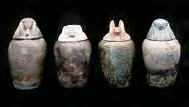ARTIFACTS
![]()
 As
part of the mummification process, the ancient Egyptian Embalmers removed
several of the internal organs from the body. These were treated and placed into
four vases, commonly called Canopic Jars. The lids were often in the shape of
the heads of the Four Sons of Horus. It is interesting to observe, however, that
the ancient Egyptians had no regard for the human brain which was removed and
discarded.
As
part of the mummification process, the ancient Egyptian Embalmers removed
several of the internal organs from the body. These were treated and placed into
four vases, commonly called Canopic Jars. The lids were often in the shape of
the heads of the Four Sons of Horus. It is interesting to observe, however, that
the ancient Egyptians had no regard for the human brain which was removed and
discarded.

This is an extraordinary collection of original jewelry, some examples of which most certainly belonged to a princess who lived during the early years of Dynasty 18. The taller, cylindrical bracelets are remarkable because their beads are still strung on the original, thin gold wire. One assumes that these jewels were placed on the princess' mummy for the symbolic value of the materials from which they were made. The gold and red stones would associate her with the sun and those of blue and green would equate her with the plant world. Just as the sun rose each day and just as plants sprouted anew with each successive season, so too, it was thought that the princess would be resurrected in the Hereafter.
 An
amulet, talisman, or charm is a personal ornament which, because of its shape,
material , or even its color, is believed to endow its wearer by magical means
with certain powers or capabilities. At the very least it should it should
afford some kind of protection. In fact, three of the four Egyptian words
translated as "amulet" comes primarily from words meaning "to
guard" or "protect". The fourth has the same sound as the word
meaning "well being".
An
amulet, talisman, or charm is a personal ornament which, because of its shape,
material , or even its color, is believed to endow its wearer by magical means
with certain powers or capabilities. At the very least it should it should
afford some kind of protection. In fact, three of the four Egyptian words
translated as "amulet" comes primarily from words meaning "to
guard" or "protect". The fourth has the same sound as the word
meaning "well being".
To see more of these fascinating artifacts click on Museum Links below
[ HOME ] [ SPHINX ] [ PYRAMIDS ] [ MUMMIES ] [ HIEROGLYPHICS ] [ ANIMALS ] [ ARTIFACTS ] [ MUSEUM LINKS ]